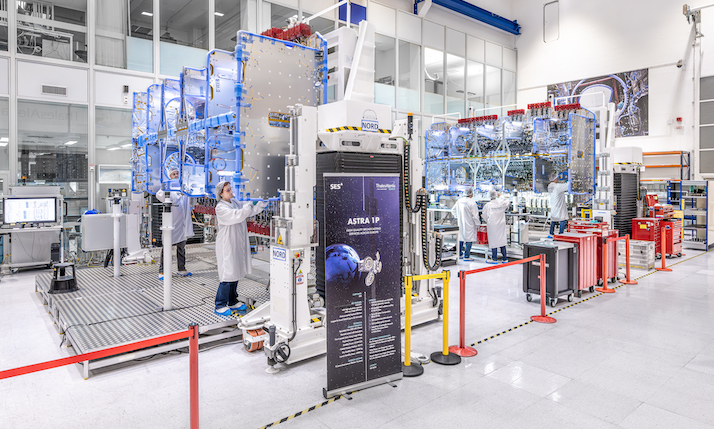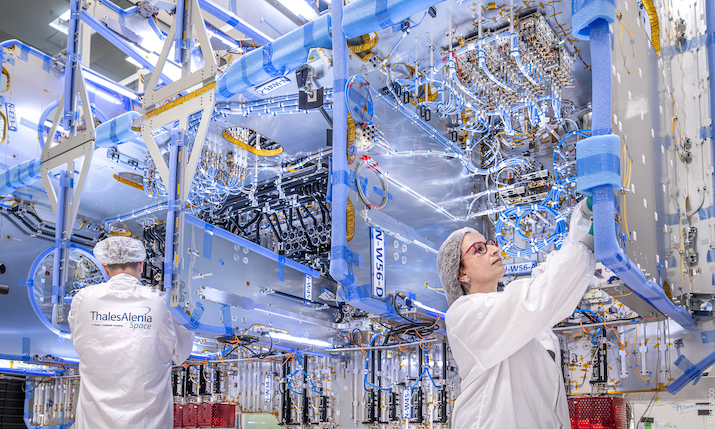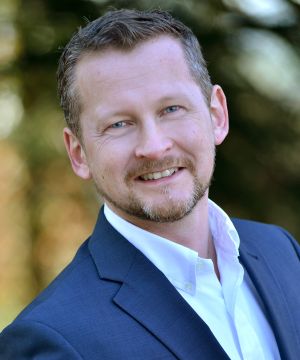Watch this space: SES set to launch most powerful satellite to orbit at 19.2E

Final testing of the Astra 1P is currently taking place at the Thales Alenia Space facility in Cannes
SES’s preparations to launch the Astra 1P GEO satellite to 19.2 degrees East are entering the final stages, with launch expected in the coming months. It will be followed by the launch of Astra 1Q – the first software-defined satellite from SES – in 2025.
Ordered in 2021 as a replacement for exiting satellites at the same position, these third-generation devices will serve major broadcasters across Europe, reaching tens of millions of viewers.
Steve Bisenius, vice president of media solutions at SES, explains: “We are currently operating the second generation of satellites at this orbital position, and Astra 1P and 1Q will be the third generation at 19.2. There’s a long history there. Our market reach on 19.2 is 119 million households between different markets. Very strong markets are Germany, France, Spain where we offer a large number of free-to-air services, but also pay-TV platforms to our consumers. And in all the other European markets which we cover we have a large household reach, where they also receive free-to-air content and some pay-TV content. As an example, in Spain, 7.4 million households are connected, in France 75 million. So this is a substantial number of households and connectivity that we give our customers to convey their content to their consumer base.”
“These days we run about 700 hours of sports events per day, which are transmitted through our satellites”
The new satellites are once again being built by Thales Alenia Space, continuing the long-standing relationship between the two companies. And, in a sign of the strength and efficiency of the partnership, the satellites are set to be delivered in record time.
“One of the key items was the delivery service beginning in 2025. So, we are now in the last two months of the programme and the satellite is quite ready. At the end of the day, we should have it on ground delivered in a record track of less than 30 months,” said Jean-Michel Bretagne, project manager of Astra 1P, Thales Alenia Space.
Astra 1P is the most powerful wide-beam satellite to ever orbit at 19.2 degrees East. It offers up to 80 physical transponders with bandwidth filters and will play a key role in augmenting and strengthening SES’s pan-European coverage. “It is there to ensure continuity and a seamless transition from the current fleet to the new fleet,” adds Bisenius. “The coverage that we have and the frequency plan is absolutely the same as for the fleet that we have there now so our customers will not see any difference, it will really be a continuity of service of what they enjoy today. The beauty of the satellite is that it provides up to 80 transponders and so offers a substantial amount of transmitting capability, allowing us to carry up to 500 HDTV channels.”
Astra 1Q, meanwhile, is part of a new breed of fully software-defined satellites that enables it to be reprogrammed in orbit to serve data markets if needed. It also opens up new opportunities for sports broadcasters thanks to its advanced technology.
“Astra 1Q brings us an additional level of flexibility. It will give us a more future proof offering and means we will be able to address changes in technology, changes in customer needs, in terms of coverage, in terms of connectivity. With this investment in both these satellites, we are securing the long-term availability of services for our customers,” adds Bisenius.
Going into detail as to the real-world benefits 1Q will bring, he says: The satellite allows us to change parameters in three dimensions; footprint, so the area which we cover on uplink, but also on the downlink side; it is the power levels that we can adapt; but it is also the bandwidth, so the transponders. Those three dimensions can be flexibly changed since it is a fully digital payload. The beauty of that is that we can offer our customers beams which are really tailored to their needs. If they need a patchwork of different regions, different countries that can be generated; if they need a restricted uplink beam, so we need to ensure that those capacities can only be reached from the ground from the particular location of our customers, we can produce that as well. So we increase reliability, we increase resiliency for transmissions.”
New business cases
This ability to create regional beams could be beneficial to the sports sector, as he explains: “For instance, we could create regional beams all over Germany, replicating the Bundesliga in Germany, and then distribute content specifically to those regions. Geofencing is also very important in terms of buying content rights. These days, customers have to go out there, they transmit pan-European via satellite. If they only need that content to be available for their customer base, which is, for example, in France, then, for that event, for that short period, we could restrict the coverage just to that area. This allows them to be more flexible in negotiating content rights for European territories. It also enables new business cases, it enables customers to be more flexible and agile.”
It could be questioned whether two new satellites are needed given much talk about the decline of linear audiences and the cost of satellite technology, but Bisenius points to research from Dataxis which shows that the actual pace of change is much slower than many may think.
While in 2007 100% of TV homes had what Dataxis refers to as classic TV reception – that is homes that are not exclusively non-linear – by 2027 this is forecast to only fall to 90%, which still represents a market of 230 million homes.
“In this industry, satellite has been talked dead for more than 10 years. Everyone says broadcasting will not survive, IPTV, online is going to take over. But, to be honest, the numbers talk differently,” adds Bisenius. “We see that, in particular, 19.2 is really resilient in terms of household reach. We’ve managed to maintain that reach over a large number of years. The ratio has been changing a bit, but the overall substance which we offer as an infrastructure to deliver content to all of those networks and ultimately to consumers remains fairly stable and resilient.”
Indeed broadcasters can reach 44% of all classic TV homes in Europe via 19.2E.

“So what is the future for satellite? Yes, overall, there is a certain reduction in classic TV homes, there are more and more households which solely consume content in a non-linear form. But, on the other side, we see a trend that consumers are using more screen time, so they are consuming more media, and that is happening in every market across the globe. We have to adapt to that trend, so we are using all the infrastructures to convey the content of our customers,” he continues.
Bisenius is also quick to point out that SES offers a wide range of services in addition to satellite, including contribution and distribution of content.
He explains: “The services that we offer range from satellite capacity in high-quality TV channels – HD, Ultra HD – and obviously transport by satellite, but we do way more than that. We also offer to our customers the distribution of their content to other infrastructures. So terrestrially via internet, via fibre; we operate online video platforms. Our portfolio range is significantly larger than just providing space segment capacity. We really enhance this to ensure that customers can get their content and distribute it in the most efficient way through the infrastructure that we manage.”

Steve Bisenius, SES
How SES is working with its sports customers has also evolved in recent years as the company has seen significant growth in this area.
“On the sports event side, we’ve seen really substantial growth in the past years, which is also due to our investment in this area and showing that for our customers who are demanding such content, we can do the bridge, we can bring the content from venues towards those broadcasters and to operators. We work very closely with sports agencies, including Infront and NFL as an organisation, where we are taking the content from the production venue in multiple feeds and in different quality versions and conveying that content from the venue utilising different infrastructure, so direct links via satellite into our network, but also via broadband and fibre links, and then from there we distribute that content towards the feed takers.
“These days we run about 700 hours of sports events per day, which are transmitted through our satellites. And we continue to move much closer to the event itself. So we are supporting live sports production and contribution of those video services through our network terrestrially and via satellite to all takers across the globe.”
To meet this demand, SES launched a dedicated satellite distribution platform, Astra 1 Sports, in 2022. This has since been leveraged for more than 2,700 events for European distribution. Thousands of hours of sports have been distributed, including FIS Alpine World Ski Championships, the World Judo Championships and FIA World Rallycross events, and it offers customers something a bit different.
“Astra 1 Sports is a platform for occasional use-based traffic, so customers can book their content there to be distributed from those sports events directly to their premises and studios,” says Bisenius.
Recent customers include the National Football League which used the platform to deliver NFL game content to over 35 broadcast partners across Europe, Asia, North and South America, and Telefonica Broadcast Services, which partners with SES to deliver events including the World Padel Tour and Valencia Marathon.
Looking ahead and it seems more innovations could already be in the pipeline. “Watch this space,” says Bisenius, “Astra 1Q gives us even more opportunities to develop.”

